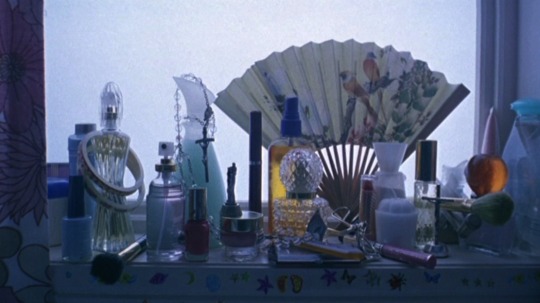#featuring teen mary sue's old bedroom
Text

some snaps from my oldie's house a little bit inspired by the house from up a version not as colorful as disney lmao bc of these very cute pictures that never left my head





#featuring teen mary sue's old bedroom#225 main street#<- well this is the terrain but i demolished the whole house to build this one from scratch#lot makeover#oldie#herb oldie#coral oldie#pleasantview#the sims 2#sims 2#(and pls ignore the floating pillows in the living room pic#i just noticed them now 😴😴😴)
89 notes
·
View notes
Photo

The Virgin Suicides (1999) is Sophia Coppola’s adaptation of the novel by Jeffery Eugenides, also being her first feature film. The inspiration for the film came from her discovery of the novel in her mid-20’s. Despite being told from a male perspective, the story still seems to be an extremely feminine yet morbid coming of age tale. Coppola never imagined becoming a filmmaker, with a focus upon fashion in her late teens into her 20’s. In an interview, she says how she wanted to make a teenage film unlike the others. “There aren’t alot of quality art films made for teenagers,” she said, which she effortlessly did, portraying themes of teen angst, sex, boys, a desire to break away from societal norms, and family. The film also was low budget, as the budget dissolved a week before filming. Coppola gives credit to the novel for inspiring her film career. Her herself was in her early 20’s, which is a period of time in which you are still trying to figure yourself out as you do in your teenage years. Reflecting upon the film 20 years later, she had came to the realization that despite the male focus upon the Lisbon girls, the film felt so personal and feminine as a reflection of her life growing up. She was always surrounded by men with all brothers and all male cousins, so she found solace in grasping to femininity. This being said, it reflects the personal touch the film has, almost bringing the viewer back to reminisce in their own days of teenage angst.
.

.
The film encompassed everything a teenage girl experiences, but brings a situation that isn’t exemplified in the typical coming of age film. The Lisbon girls, 13 year old Cecilia, 14 year old Lux, 15 year old Bonnie, 16 year old Mary, and 17 year old Therese, lived in a home of a scholar father, and a mother who was the obvious source of dominance and constriction in the house. The girls lived an extremely strict lifestyle, never being able to have interactions outside of their home and school life, never to dress in any manner that wasn’t conservative, and especially no romantic relations. The setting of 1970’s Michigan in an extremely tight knit neighborhood made their situation stand out from the other children in the neighborhood. Everyone knew one another, even if they had never interacted; and everyone knew the mysterious Lisbon girls. The film also visits religion quite frequently. The mother, Mrs. Lisbon, is a very high strung catholic. In many scenes, starting from the very beginning there is imagery of the Virgin Mary and sigils placed seemingly everywhere. A notable symbolic image is a card of the Virgin Mary, which we see in the opening scenes as Cecelia lays unconscious in the bathtub after her first suicide attempt. The card lies on the floor, splattered in blood. The themes associated with religion seem to be displeasure and breaking away. The theme of femininity also ties into the religious aspects. Despite the girl’s disapproval yet lack of voice upon their mother’s strictness and beliefs, every religious image is very feminized. Every time we see a rosary, or crosses, they are always surrounded by jewelry, flowers, perfume, intricate glass wear, makeup or small trinkets. The ratio to these objects is usually many feminine items with just one or two religious symbols, which displays an overpowerment that they could never express themselves. There is a profound sense of freedom the girls display, yet having no freedom at all. They are restricted by the boundaries of the religious values their mother follows, yet still embrace their girlhood and find ways to enjoy their femininity despite this.
.

.
The most profound technique I found in the film was the use of the soundtrack in accordance to each scene. For example, in this particular scene, the girls had begun to communicate with the boys through morse code; due to Lux not coming home on the night of prom, the girls were under house arrest. Lux was forced to burn all of her records, so the boys spend hours upon hours playing music through the phone for the girls. In this scene which shows a progression of the boys projecting the music overtime, and the girls listening, the song “Alone Again Naturally,” by Gilbert O’ Sullivan. Although the boys never personally knew the Lisbon girls, and had had only one interaction with them at most, there was a sense of loneliness coming from the boys as they dedicated so much time to please the girls. The girls had been granted the slightest amount of freedom to attend the dance, and because of Lux never returning home that night, they had once again returned to seclusion, but even stronger than before. In another scene, during Cecilia’s party, as she excuses herself, the song “The Air that I Breathe,” by the Hollies plays. In some sense, it acts as very ironic foreshadowing. For the entire duration of her party, Cecilia sat alone in the corner, while all of the other boys socialized with the older girls. Joe, the boy with special needs, was the only one kind enough to say hello to Cecilia and give her attention. The music abruptly stops when a sound is heard, and the father is found standing outside with Cecilia’s lifeless body impaled through a spoke in the fence.
.

.
This scene in particular occurs directly after Trip leaves the Lisbon household after spending time with Lux as the mother sat in between them. Trip goes to his car, flustered and sits back in the seat with his head back and eyes closed, visibly flustered. From his body language, you can assume that this response was due to the lust from Lux’s embraced sexuality that she displayed very quietly so no one would catch on besides Trip. Through his car window we see the upstairs middle light turn on, which we can assume to be the parent’s bedroom. The car door opens, and Lux jumps in and immediately begins to make out with Trip. At the same time, the song “Crazy on You,” by Heart plays. The dynamic in this scene has clear sexual tension, and also highlights the theme of disobedience and teenage angst. Trip knew what he was getting himself into by trying for a girl in such a reserved family, but also with the knowledge that Lux had a personality unlike her sisters. In the reading “Pleasure in Looking/ Fascination with the Human Form,” the term scopophilia is brought up, which is the pleasure of looking. In Freudian theory, humans enjoy viewing things that bring them pleasure, and the idea of voyueristic viewing enhances this pleasure further. Cinema essentially fulfills every aspect of scopophilia; we as the viewers are watching Lux and Trip has this passionate moment, and as a viewer of two subjects within a scene, there is no possible way for them to have any knowledge of this. Having insight into an intimate moment reflects upon the viewer, and you can almost relate the the sexual tension from a personal reflection of your own experiences, and from your own teenage years.
.

.
The film definitely acts as the most absurd coming of age movie you can get. In comparison to a film such as say, Sixteen Candles, there is no existential crisis that is met with a resolution that acts a life lesson. The boys are under the impression they will final have the moment they craved since the beginning of the film; to take the girls and run off and have what they imagined to be the time of their life. Instead, the girls had other plans the entire time. As the boys wait, each girl meets her demise. Bonnie was hanging, Therese overdoses on pills, and Lux is found with her fingers still clutching a cigarette, dead in the garage from carbon monoxide poisoning. If anything, the film is an anti coming of age film, yet the strong vibes of femininity and softness make the viewer feel as if it’s the complete opposite. Surely families exist as the Lisbon’s, yet the strong theme of escapism through death is hard to tell as the movie progresses.
.

.
The tile of the film itself relates back to the major theme of religion. This theme doesn’t feel so prevalent aside from the imagery, but breaking it down becomes more understandable. In Catholocism, a virgin is a figure of purity, free of sin. The Virgin Mary was a saint because she was so pure, and conceived a child while never having sex, upholding her virginity. Despite Lux losing her virginity to Trip, the girls were viewed by everyone around them as completely pure girls who were perfect from their blonde hair down to their mysterious nature. All of the sisters met their demise through suicide, Cecilia being the first and the rest through a suicide pact. The title has two contradicting topics in nature; virginity and suicide. Maybe this acts as a not so gentle reminder that absolute purity does not always equate to perfection, as the matriarch mother believed. In fact, she believed that she raised her children perfectly and never did anything wrong. The film makes you question where true happiness actually comes from. In the mind of the family, upholding perfect standards of purity and Catholic values, and sheltering the girls from anything that could harm them, was the best way. The girls always wanted freedom, even if Lux was the forefront of breaking away from her family’s expectations. In the end, there is no perfect definition of what true happiness is. Everyone will always want what they truly desire, not what others confine them to. – JA
.
https://theplaylist.net/sofia-coppola-criterion-virgin-suicides-20180502/2/
.
Mulvey, Laura. “Visual Pleasure and Narrative Cinema” [1975]. Feminist Film Theory: A Reader. Ed. Sue Thornham. New York: New York University Press, 1999. 58-69.
.
https://www.theguardian.com/film/2018/jan/25/sofia-coppola-on-the-virgin-suicides-director-debut
.
https://thedissolve.com/features/movie-of-the-week/1076-the-virgin-suicides-is-a-window-into-sofia-coppola/
6 notes
·
View notes